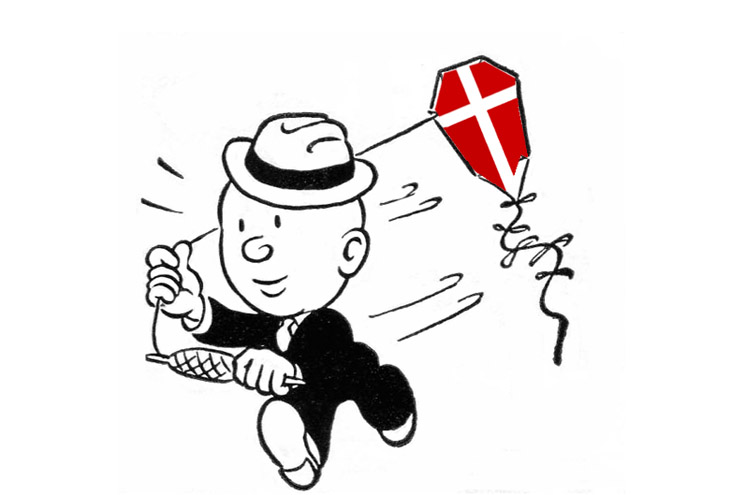My apologies that I haven’t been blogging for the past couple of months – I’ve taken some time off to promote my book Top 35 Mistakes Danes Make in English, which you can get on Amazon or Saxo.com, or at any Danish bookstore.
But taking time off is a very important part of Danish life – in fact, some people would say it is one of the best parts of Danish life.
The best example, of course, is the famous Danish summer vacation. When I first began working in Denmark, people used to start saying around April or May, “So – are you taking three or four?”
What they meant was, are you taking three or four weeks off for your summer vacation?
Vacation as a human right
Now, in the United States, where I come from, even taking two weeks off is extravagant. You always have the feeling that if you’re gone too long, there may not be a job waiting for you when you get back.
In Denmark, a long summer vacation is legally required. If you have a full-time job, you get six weeks annual vacation, and your boss is legally required to allow you to take three of those six weeks sometime between May 1 and September 30.
Even if you’re unemployed, you get paid time off from looking for a job so you can enjoy time off in the summer. And there’s been a lot of controversy this year about whether the newly arrived refugees in Denmark should also get paid vacation from their required Danish language lessons.
Many Danes consider vacation to be a human right. Any discussion of poverty in Denmark is likely to include an interview with a person on the minimum kontanthjælp sincerely complaining about his inability to afford a vacation abroad. If you get sick during your vacation, you can even request more time off to compensate.
That’s the social welfare state – I hope you all enjoy paying taxes to support it.
Time off makes for great small talk
Ironically, the people who pay the most taxes don’t always get to enjoy the longest vacations. People who work for themselves, like me, take relatively little vacation – I took 10 days this summer, and I know other busy self-employed people who took none at all.
But vacation is still a very important part of Danish culture. You can always make small talk with a Dane you don’t know very well by asking where she went on her last vacation, or where she intends to go on her next one.
There’s not just summer vacation. There’s fall vacation in October, and of course Christmas vacation. Winter vacation is in February (maybe a ski trip) and there are a minimum of five days off over Easter, plus some odd one-day holidays speckled through May.
It doesn’t mean everybody travels every time. You might do a renovation project around the house – most Danes have a passion for fixing up their houses – or spend time in the summer house, or attend some big family event like a wedding, a confirmation, or an 80th birthday.
Strategic timing of your vacation
If you work on a team with several people, you’ll have to agree who gets to take which weeks off on vacation. Reserve as far in advance as possible; your colleagues will.
And choosing your optimum vacation time requires a little knowledge of Danish culture.
For example, the last two weeks in July are a dead zone for business in Denmark; many companies close down entirely. If you’re able to stay on the job during this period, it’s a great time to get some peace and quiet around the office. Commuting is easy – the streets of many big cities are largely empty – and you can finalize big projects without being constantly interrupted by meetings.Or you can just clean off your desk and organize your computer.
I used to do this a lot before my daughter began school and I found my summer vacation opportunities defined by the school holidays, just like hundreds of thousands of other parents in Denmark.
School summer holidays usually last about five weeks, from late June to early August, and prices for air fare out of Denmark and places to stay within Denmark double within this period. If you don’t have kids, or if your children are too young for school, you can save a lot of money by scheduling your “summer” vacation in May or September. And your colleagues with school-age children will thank you.
The risk of working during other people’s vacations
Other times the office will be dead include the three days before Easter and the week between Christmas and New Year’s. If you’re not doing anything else, this is usually a convenient way to get full pay for some slow days at the office.
Occasionally, though, some unexpected situation can come crashing down on your head and you will be the only one around to handle it. If it does, it’s considered poor style to call your boss and interrupt her vacation. Unless it’s an acute emergency, time off in Denmark is sacrosanct.
No paid vacation for your first year working
Unfortunately, if you’ve just arrived in Denmark and are looking forward to your paid vacation, I have some bad news for you. The first year on the job, there is none. Unless you have a special arrangement with your employer, each year’s time off is paid for by time saved up the year before. In your first year, you’ll still get the time off, but it won’t be paid. Next year you’re covered, though, even if you change jobs in the meantime – the “vacation money” system is run by the government.
But even in your first year on the job, you can start enjoying the Danish Way of Taking Time Off right away. You can leave work precisely at 4 – or at 3:30 on Fridays. You can avoid working evenings or weekends. And you can mostly ignore business calls after hours, and neglect to answer business emails when you’re not in the office – except maybe on a Sunday night.
With some exceptions, the Danish way is to spend this time with your family. And if you don’t have a family, to spend time with your sports club, or your apartment building’s tenant organization, or to take up oil painting with the inexpensive paints and canvases that always seem to be on sale at Danish supermarkets.
Otherwise, you always can fix up your house.
Buy Kay’s books about Denmark on Amazon, Saxo, Google Books, Apple Books, Barnes & Noble Nook, or via our webshop.
Image mashup copyright Kay Xander Mellish 2025
Read more:
Decoding your Danish pay slip and understanding your Danish taxes
How to handle a Danish business meeting
What to wear to work in Denmark: Quiet colors, quality cut and fabric
Your first day at work in Denmark: Handshakes, passwords, and several people named Mette
Trailing spouses and working in Denmark
Motivating Danish employers: Tips for foreign managers
Networking in Denmark: 5 useful tips for making Danish business contacts
Secrets of socializing with your Danish colleagues
Your free daily banana and five weeks off: Job benefits in Denmark
Why job titles aren’t that important in Denmark
The Danish job interview
Job search in Denmark: Your Danish cover letter plus LinkedIn plus two magic words
Job hunting in Denmark: Putting together your Danish CV
Fine-tuning your approach to the Danish job market
Finding a job in Denmark: Some tips from my experience
Is joining a union a waste of money? And what is the difference between a union and an A-kasse?
Will I ever be promoted? Plus, how to leverage your annual review
Taking sick days in Denmark, plus how to deal with stress





